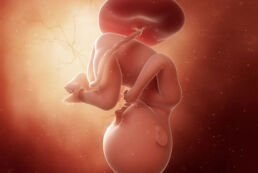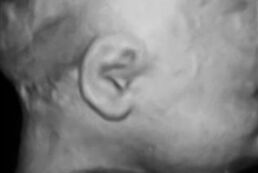Baby's Height and Weight
At 35 weeks of pregnancy, the baby’s height is about 46-47 centimeters, the size of a large melon. The baby weighs about 2400 grams.
Development of the Baby

Your baby is now so conscious that she is preparing for childbirth. She is probably now turned upside down (cephalic position) so that she can easily get out of the womb. If your baby still hasn’t turned upside down this week, wait a few more weeks. Approximately 96percent of babies turn upside down until birth. The face of the baby, who turns upside down and takes the birth position, should face back in recent weeks (anterior position). This posture is also advantageous in terms of cesarean surgeries.
At 35 weeks of pregnancy, the brain and nervous systems are fully developed. Brain cells continue to increase.
At 35 weeks of pregnancy, fine hairs (lanugo) on the baby’s skin continue to fall out. The Verniks Kazeoza layer, a thick, pasty, white and oily structure that has been forming on the surface of the skin for weeks, provides temperature control of the body and protects the baby’s skin from the acidic environment of the amniotic fluid. At the same time, there is the task of facilitating the passage of the baby through the birth canal at birth. In natural birth practices, it is ensured that the vernix layer remains on the babies’ skin for a while after birth, that is, the baby is not washed immediately. Thus, it is ensured that this oily layer continues to keep and nourish the baby’s skin during the adaptation to the outside world. In this application, even if it is washed within 12-24 hours, some of the vernix is washed so that it remains in the baby’s body.
At 35 weeks of pregnancy, the baby’s skull bones are still soft, even if they continue to harden. The skull bones have not yet come together. There are soft tissues called fontanels between them. This soft area in the baby’s skull is called the fontanelle, and the complete closure and hardening of these tissues will only occur until the baby is 1-1.5 years old.
At 35 weeks of pregnancy, the baby’s first black poop, called meconium, continues to accumulate in its large intestines. Babies are not expected to do this poop until birth. Baby pooping in the womb may pose a health risk. If such a thing is noticed, the doctor’s decisions must be strictly followed.
Baby Movements at 35 Weeks Pregnancy
Your baby’s space is tight, but it still continues its vigorous movements between naps. You can also feel their hiccups. If the head is turned down, you will occasionally feel your baby’s butt under your stomach. Some expectant mothers say that they feel the pressure of their baby’s feet and fingers very clearly during these weeks.
Ultrasound Image

Only a few weeks left for his lungs to fully develop. In the meantime, your baby continues to make breathing movements by regularly swallowing amniotic fluid. You can see this breathing movement in the 35-week pregnancy ultrasound images.
You can also see on the ultrasound that your baby continues to suck on his thumb or other fingers. This allows her to develop the sucking muscles that she will need to be able to suckle her mother’s breast after birth. The suction reflex will only fully develop at the end of this week. For this reason, babies born before 35 weeks may have some difficulty while breastfeeding.
At 35 weeks of pregnancy, your doctor will look at your baby’s position on the ultrasound. If he still hasn’t descended to the head-down position, there’s still some time for him to descend. But perhaps your doctor may recommend doing a spinning procedure that will make your baby turn upside down from above your stomach (he/she can do it himself/herself or recommend a professional midwife). This should be done by an experienced specialist. The chance of success in the procedure is 2/3. Remember, this procedure will definitely require your doctor’s approval! In addition, your doctor may ask you to do some exercises that you can do at home to make your baby turn upside down. If he didn’t suggest it, ask him. If you have a midwife or doula for whom you receive one-to-one support for childbirth, they can support you in this regard with the approval of your doctor.
Changes in the Mother's Body
How many months is 35 weeks? You are at the end of the 8th month of your pregnancy.
The size of your belly may have started to seem incredible to you. But remember that there is only one purpose for you to come to this boom point, and that is to bring your adorable baby into the world. You may also be worried that your stomach will not be the same as before. Fortunately, all those negative feelings will pass after the birth, and you’ll be surprised to see how your belly can return to normal as the months go by. You’ll have to put some effort into getting your belly back up and tight. Here are our recommendations:
– Do not gain more weight than necessary during pregnancy,
– Moisturize your abdomen by applying natural oils such as almond oil, cocoa butter or coconut oil or blended oils obtained from them every day,
– Perform postpartum puerperal exercises. They will help you if you ask your birth supporter for these exercises (midwife or doula),
– At 35 weeks of pregnancy, your center of gravity will change as your belly grows, which will restrict your movements. It’s best to move slowly with your growing belly. Performing repetitive movements brings unwanted accidents such as loss of balance, falling, spraining of the foot. However, even if we say “You need to move slowly”, do not lie down constantly during these periods. Because moving will make it easier for you to give birth. Your actions, though, should be careful and attentive.
You may continue to experience groin pain during 35 weeks of pregnancy. This is due to tension and stretching in the muscles around the uterus due to growth.
So, is it possible to give birth at 35 weeks? Of course it is. You may experience symptoms of preterm labor at 35 weeks. If your groin pain is accompanied by one or more of the symptoms of premature birth, be sure to inform your doctor. (For information on the signs of premature birth, see our 33rd week article.)
At 35 weeks of twin pregnancy, the babies may not have turned upside down. Or one can be upside down, the other can turn sideways. It is advantageous for normal birth if both have turned down. If both are standing on the side, it may be more ideal to have a cesarean delivery. If everything is fine and you want to have a normal birth, you should choose a doctor and midwife who are experts in twin births.
Is Your Body Structure Suitable for Childbirth?
Up until birth, expectant mothers mostly wonder whether their body structures are suitable for birth. Let us comfort you as follows; Even if the father is very tall and large and the mother is short, babies are usually born in proportion to their mothers’ measurements. If your doctor suspects your baby’s head size during your pregnancy, they will follow you to birth and guide you. Also, some women with gestational diabetes may have very large babies weighing over 5 kilograms. This can make it difficult for the baby to be born. The doctor will again direct the mother in such a case.
In addition, the bone structures of babies are flexible until birth so that birth is comfortable. Likewise, the tissues in the joints of a pregnant woman soften, which makes it easier for the pelvic floor to stretch during childbirth. At the same time, remember that your baby’s skin surface will be born with a vernix caseosa layer. This fatty structure, which is formed on the surface of the whole body, including the head of the babies, allows them to slip easily from the mother’s womb. In short, after the birth begins, you and your baby will be equipped to perform the labor easily. If you have a professional birth supporter who will support you one-on-one, your birth will be comfortable.
Points need to be considered
If your sleep has started to be interrupted at the 35th week of pregnancy, Be sure to take a look at the suggestions we gave in our week article.
Pay attention to your diet so as not to increase your stomach problems. It’s best to eat often and less. Avoid excessive consumption of sugary foods as this can lead to unnecessary weight gain. Do not forget to drink plenty of water (8-10 glasses a day).
Canbebe on Social Media!
Join our community of mothers and fathers on social media. Be close to caring community, sharing advices between each other on our everyday life with our baby.
